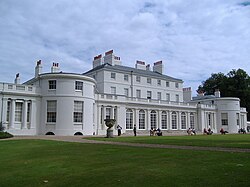Frogmore House
| Frogmore House | |
|---|---|
 Frogmore House in 2006 | |
| General information | |
| Location | Frogmore, Home Park |
| Town or city | Windsor, Berkshire |
| Country | England |
| Coordinates | 51°28′27″N 0°35′39″W / 51.4743°N 0.5943°W |
| Completed | 1684 |
| Client | Anne Aldworth and Thomas May |
| Design and construction | |
| Architect(s) | Attributed to Hugh May |
Frogmore House is a 17th-century
History
Early tenants
The Frogmore estate has been under royal ownership since the 16th century and was then leased to a series of Crown tenants. Construction on Frogmore House was not begun until 1680 for tenants Anne Aldworth and Thomas May. Work continued until 1684 and is thought to be the work of Hugh May, an architect employed by Charles II at Windsor Castle and uncle of tenant Thomas May.[1]
The house's first royal resident was
Royal retreat
Queen Charlotte used the house as a country retreat for herself and her unmarried daughters. They used Frogmore as a "refuge" away from court life where they could practise their pastimes of "painting, drawing, needlework, japanning, reading and 'botanising'". The Queen's interest in botany is reflected in a number of the rooms at Frogmore, including a room decorated with painted flowers by the artist Mary Moser.[1][2] Great attention was paid to the gardens, where the queen planted a number of Spanish chestnut, laburnum and birch trees and installed a number of follies.[1]
The house was in good condition, but to make it fit for royal inhabitants, James Wyatt was employed to enlarge and modernise Frogmore House. Between 1795 and 1804, Wyatt enlarged the second floor, added flanking pavilions to the north and south of the house and extended to make room for a new dining room and library.[1] As part of developing Frogmore's gardens, Queen Charlotte had built a simpler retreat house in 1801, now known as Frogmore Cottage.[3] When Charlotte died in 1818, she left the house to her daughter Princess Augusta Sophia, who lived there until her death in 1840.[1]
-
The Dining Room, 1819
-
The Japan Room, 1819
-
The Queen's Library, 1817
-
The Green Pavilion, 1817
Following Augusta Sophia's death, Queen Victoria gave Frogmore to her mother, the Duchess of Kent.[2] During this time, the house was subject to a number of alterations. The Duchess's taste differed greatly from Queen Charlotte's and much of the decoration from her time was lost.[4] The house was used regularly between 1841 and the death of the Duchess of Kent in 1861, with Queen Victoria often visiting and a number of private family functions being held there. Victoria wrote of the house: "All is peace and quiet and you only hear the hum of the bees, the singing of the birds and the occasional crowing and cackling from the Poultry Yard!"[1]
Recent history
Frogmore was used intermittently for the remainder of the 19th century.
During this time, George V allowed his first cousin Grand Duchess Xenia Alexandrovna of Russia to live at Frogmore Cottage by 1925 after she escaped the Russian February Revolution. Xenia was "very grateful" that her cousin let her stay at Frogmore. By March 1937, Xenia had moved from Frogmore Cottage to Wilderness House in the grounds of Hampton Court Palace.[6] Since 1928, most members of the royal family, except for sovereigns and their consorts, have been interred at the Royal Burial Ground, on the Frogmore Estate.[7]
In 1997, following the decommissioning of the Royal Yacht Britannia, Prince Philip, Duke of Edinburgh, furnished what had previously been Queen Charlotte's library and the Duchess of York's dining room with a selection of items from the vessel. This included a mahogany table constructed for Britannia c. 1950.[2]
The house continued to be used by the royal family for entertaining and it was used as a venue for the
Restoration
During the 1980s, the house underwent extensive restoration, revealing the lost early 18th-century wall paintings by Louis Laguerre.[9] Work was also done on the Green Pavilion, in an effort to restore it to its appearance during the occupation of Queen Charlotte. Work was done on the cornice, dado and chimneypiece, which retain Wyatt's "characteristically crisp detailing."[1] The restorations cost a total of £2.5 million by the time they were completed in 1990.[4]
See also
References
- ^ a b c d e f g h i "About Frogmore House". Royal Collection. n.d. Retrieved 11 February 2015.
- ^ a b c "Guided tours of Frogmore House". n.d. Retrieved 11 February 2015.
- ISBN 978-0-300-07079-8.
- ^ a b Campbell Dixon, Anne (17 May 2003). "Windsor: The glory of a grave affair". The Telegraph. Retrieved 11 February 2015.
- ^ "Frogmore House". Retrieved 10 January 2021.
- ISBN 0750935219.
- ^ Davies, Caroline; Jones, George (11 February 2002). "Princess is likely to be buried at Windsor". The Telegraph. Retrieved 11 February 2015.
- ^ Spranklen, Annabelle. "Frogmore House: the Royal Family's secret Windsor retreat". Retrieved 19 May 2018.
- ^ Sawer, Patrick (3 March 2019). "Duke and Duchess of Sussex to move to Frogmore House and begin family…". The Telegraph. Archived from the original on 3 March 2019.





